
In part one of this multi-part series of articles, we discussed what to know and why to know about development impact fees. If you missed part one, you could find that article here. In our second part, we briefly discussed some of the history of developer fees for school facilities in California. In part three, we briefly discussed the three levels of fees. In part four, we discussed special circumstances and use of fee. Part five discussed adopting and increasing the fees.
In this article, we discuss collecting fees and accounting for the collected fees. Let’s dive in now and allow me to share some thoughts on this subject.
We led up to this in our previous discussions. The idea and notion of a fee being collected stems from having taken the appropriate steps to complete your Developer Fee Justification Study. That document, along with your adoption procedure, set the stage for now collecting, using, and accounting for the fee.
Fees are collected, usually, following the final inspection, or date of occupancy for the project which the fee is being collected. There are other circumstances that often occur, perhaps when you negotiated with the developer to collect the fee based on an agreement between the district and the developer. Sometimes, you will have negotiated with the developer to reimburse costs for expenditures made, and agreed to in advance, and the fee is collected for those specific agreed to expenditures.
It is best practice for districts to collaborate with cities and counties on this process. There are often differences in the way accessible space is calculated and addressed. Having a good relationship with the local agencies will ensure there isn’t a challenge later between the district and the developer due to a miscommunication or misunderstanding of what the local planning agency determines as accessible space for purposes of the fee. A recommended best practice if for district to develop their own certificate of compliance and include a section in this document for City/County to provide this information. Again, maintaining a strong working relationship with local agencies is a highly recommended best practice.
It is often asked whether or not districts can recover cost for collecting the fee and preparing the justification study. Short answer is yes, a district is allowed to use up to three percent of the collected fees to offset their administrative costs. The fee may be used to pay the cost of preparing the justification study, too. A district is allowed to apply the three percent toward the cost of staff time for collecting the fee, but only three percent in any fiscal year.
Government Code sections 66001 and 66006 require districts account for collected fees annually and show use of the fee over a five-year period. Some districts will separate this reporting requirement into a report of annual collected fees and separately report the planned use of the fee over the five-year period as required in this section of code. More often, we find a combined report serves to meet this requirement.
The five-year report is a plan of action and projection of how the district intends to use the collected fees over this period of time. This report shows the need for ongoing facilities needs throughout the district and states the overall use of the collected fees for this period of time. The five-year report is updated annually to reflect projects underway, completed, or planned over this timeframe.
The five-year report states the nexus for collection of the fee from the development and the intended use of that fee for identified and anticipated projects of the district. As you may have experienced already, the fees lag behind the needs of the district so collection and reporting of how the fee is or is planned to be used identifying ongoing construction needs is necessary.
This report is due within 180 days of the end of the fiscal year. Planning for this report is needed to avoid situations where repayment of the fee may become required. Accurately stating use of the fees and accounting for the expenditure of the fees is done in this report to account for construction and/or improvements showing when they will commence. This helps avoid requirement to refund any fee that is unused to the developer that paid the fee.
The five-year report starts in the year collected and accounts for the collected fee over the course of it’s reported and stated use. The five-year report is provided to the governing board within the 180-day reporting period, with the annual report (most often a combined report). This is a public report made available for public review, within this codified period. A recommended best practice is to prepare this report in October in order to complete the governing board and public review in early December. There are many holidays during this time of year that will add to the need for being out in front of the process to ensure adherence to the required deliverable, 180-days from close of fiscal year.
It is highly encouraged that the reader review Government Code section 66006 to ensure compliance with the timelines related to having this report available for review by the public. The requirement includes a 15-day notification of when this report will be made available. There are additional requirements in this section of code addressing sending notices to any party that has requested notification, be sure to check this and be prepared in advance for the board meeting.
Our next article will focus on permissible and impermissible uses of collected fees. A future article in this series will address level two and three fees. Stay tuned!


